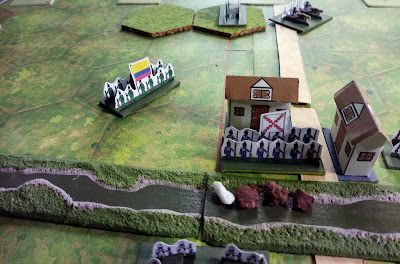'Simplicity in Hexes' (SiH) is an adaptation of Neil Thomas's 'Simplicity in Practice' (SiP). It's designed for fighting scenarios from One Hour Wargames using forces with about six units per side. SiP was written to fight the various CS Grant 'Tabletop Teaser' scenarios on a 3' x 2' table. So this got me thinking; could SiH be used for a tabletop teaser?
Coincidentally, in
Battlegames 23, the issue which contains 'Simplicity in Practice' there is a CS Grant teaser - Cavalry Encounter. Both armies are exactly what you'd expect - cavalry. Red Force is riding hard to seize a strategic river-crossing. Blue Force has got wind of this, and has sent a force through the night to intercept and block them. The two forces approach from opposite corners. Red is surprised by the force in front of it and must organise for battle. Blue is ready for battle, but has troops tired after the night's ride. And, to top it all, the terrain, whilst seemingly good cavalry country, may contain unexpected difficulties. Red must break through Blue's force with enough strength to seize the crossing. Blue must force Red to withdraw. Here's the map.

And here's my adaptation of it to hexes. I used a 6 x 9 grid. I left off most of the scattered trees, as the rules aren't granular enough to use them, although I did put one wood on the board. I included the two central farms, as they seemed significant. The black counters were randomly paced in the central third of the board, between the two forces. If a unit moves adjacent to one, the player rolls a D6. On a 6 the terrain in that hex is impassable marshland. If a road passes through it, units may enter and leave the hex along the road only.
As ever I set the scenario during one of Bolivar's Venezuelan campaigns. The Royalist cavalry is attempting to reach the river crossing, whist Bolivar has sent his finest horsemen to stop them.
Here are the Royalists. In the original scenario they have restrictions on their orders on the first couple of turns. Since I use the card-driven initiative system, I simulated this effect by only including two cards for the Royalists in the deck on the first turn.
Bolivar's men are active from the first turn, but all units start with an exhaustion marker. This counts as a temporary hit on the unit. If the unit moves, or takes part in a combat then the marker is converted to a permanent hit. The unit can try to remove the marker instead; when activated they roll a D6, and on a 5 or more it is removed.
So that's the battle. The Royalists are slow to get started, but the Patriots have to try and recover their force as quickly as possible, or choose to fight at a disadvantage.
The lead Royalist units moved forward rapidly to scout the terrain, and found an area of boggy ground straight away.
They swung to their left, where they encountered a Patriot unit that had taken position on the northern hill, and drove it off.
The Patriots were slow to recover, but pushed their left lank forward to cover the southern approach to their position. The Royalists rushed along the road, discovering more boggy ground as they did so.
The Royalist left pressed their advantage, and routed one of the Patriot units.
The Patriots counter-attacked, but their force was still tired, and their advance was fragmented. The Royalists pushed forward confidently.
They pushed another attack over the northern hill, and shattered the Patriot right flank.
A drive down the road in the centre also saw the Patriots pushed back.
Local charges by the Patriots left a couple of Royalist units seriously weakened, but the Royalists now had the numbers and position to gain an advantage, and a final charge saw the Patriot force all but destroyed.
The last Patriot unit withdrew in the face of all six Royalist units.
So an easy win for the Royalists.
If I played this again I'd make a few changes.
(i) Reduce the northern hill to two hexes; it dominated that part of the board a little too much.
(ii) Have the Patriot units recover on a 4+
(iii) Slow the Royalists a little more at the start by maybe only giving them two cards on the first turn, then four on the second, and not giving them the full six until the third turn. Both this and the previous change will leave both sides deciding whether to push forward and grab a tactical advantage with a few units, or hold back and wait for their whole force to become ready.
And in terms of Simplicity in Hexes, I allowed units to move adjacent, but not charge. If a unit moved adjacent to multiple enemies then it had to attack an opponent's front before any flank hexsides that were on offer.
And to answer my initial question - Yes, it appears that SiH can be used to fight Tabletop Teasers.

































































